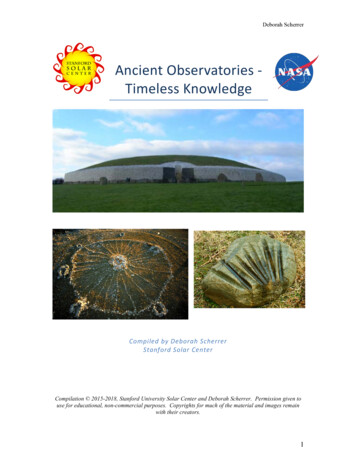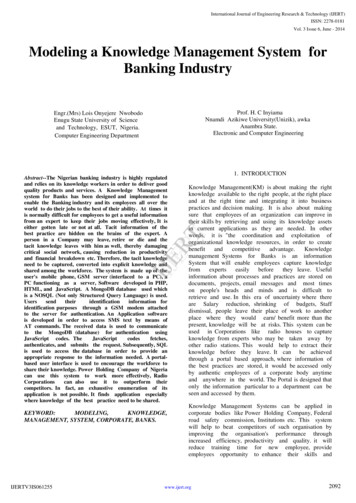
Transcription
Deborah ScherrerAncientObservatories- ordSolarCenterCompilation 2015-2018, Stanford University Solar Center and Deborah Scherrer. Permission given touse for educational, non-commercial purposes. Copyrights for much of the material and images remainwith their creators.1
Deborah ScherrerTable of ContentsIntroduction to Alignment Structures . 3Monuments . 4Steppe Geoglyphs . 4Goseck Circle . 6Nabta Playa . 8Temples of Mnajdra . 10Newgrange . 12Majorville Medicine Wheel . 15Stonehenge . 18Brodgar . 20El Karnak . 22Abu Simbel . 24Gotland Grooves . 26Chankillo . 28Rapa Nui / Easter Island . 29Chaco Canyon / Sun Dagger . 31Chichen Itza . 34Angkor Wat. 36Hovenweep Castle . 38Bighorn Medicine Wheel . 40Gaocheng . 42Machu Picchu, Cuzco, & the Incans . 43Jantar Mantar . 47Bracewell Sundial, Stanford University . 48Bracewell Radio Sundial. 51Rock Art . 53Paint Rock . 53The Sun Dagger . 54Ancient Navigation by the Sun – Sunstones . 56Solstices, Equinoxes, and Zeniths, oh my! . 59Introduction . 59The Sun’s apparent path in the sky . 59Solstices . 60Zeniths & Nadirs . 60Putting it all together. 612
Deborah ScherrerSee also the Stanford Solar Center: AlignmentStructuresAncient cultures attempted to track the motions of the Sun and Moon, measure time, andrelate their world to the world above (and below) through glorious and enigmaticstructures they built. This document highlights a collection of sites, prehistoric andotherwise, that include artifacts related to tracking the Sun and often the stars. This is notan exhaustive list, just a sampling. Because few written records exist, we can onlysurmise from the evidence what purpose these sites might have served for their builders.The sites are listed in approximate chronological order.To the peoples who built these structures, the complicated and cyclic nature ofmovements of the Sun, Moon, planets, and stars represents a kind of perfectionunattainable by mortals. The regular occurrence of sunrise and sunset, moon rise and set,could have provided the ancients with a dependable and orderly sense of time, a stablepillar on which to anchor their thought and behavior and integrate it into their view of theskies above. The sky god’s return to a particular alignment was the time to plant thecrops, that the rains would soon come, or that tit was time to prepare a particularceremony to appease or thank the gods. We cannot overestimate the importance ofpredicting and following seasonal change among these early peoples (Aveni 1997 p. 82 ,55).Our forbearers followed their sky gods’ movements attentively. By marking theirappearance & disappearance with great care, they combined religious worship withpractical knowledge. The cycle of planting and harvesting crops was regulated bycelestial events; important days of celebration and festivity were marked in a celestialcalendar. After generations they learned to predict particular celestial phenomena, suchas eclipses, well in advance. Understanding what happens in the sky is the basicprerequisite for appreciating other people’s conception of the heavens. What are thesignificant sky events the ancients may have watched? (Aveni 1997 3-4)Following is a collection of sites, prehistoric and otherwise, that includes artifacts relatingto tracking the Sun and often the stars. This is not an exhaustive list, just a sampling.Because few written records exist, we can only surmise from the evidence what purposethese sites might have served for their builders.The sites are listed in approximate chronological order3
Deborah ScherrerMonumentsBefore Current EraSteppeGeoglyphsLocation: present-day Turgai, KazakhstanDate Constructed: 8000-2000 BP?Latitude: 48.0º NLongitude: 68.0º EImage credits: All images DigitalGlobe, viaNASAThe largest of the earthwork configurations,photographed from space, is known as theUshtogaysky Square, named after the nearestvillage in Kazakhstan.Construction:The Steppe Geoglyphs are a collection of 260 earthworks constructions in the TurgaiTrough area of Turgai in northern Kazakhstan. Most of them consist of smallerearthworks arranged with each other to make squares, rings, crosses, and even amysterious 3-armed swastika-like shape. Thecomposite figures range from around 90 meters inlength to over 400 meters in diameter. The largest,shown above, is a giant square of 101 raisedmounds, its opposite corners connected by adiagonal cross, covering more terrain than theGreat Pyramid of Cheops.Because of the nature of the clay soil, thesemassive structures must have required enormousefforts to build.The oldest of the constructions is estimated at8,000 years old. Early archaeologists foundartifacts of a Neolithic settlement 6,000 to 10,000years old, including spear points.One curious mound appears in the shape of a swastika. The swastika symbol is derivedfrom the Sun Cross image (Neubecker 1976. p. 42), and was often conceived of as asymbol of the Sun.4
Deborah ScherrerAlignments: A Kazakh economist and archaeology enthusiast, Dmitriy Dey, spotted themounds on Google Earth in 2007. In 2015, NASA released clear satellite photos of someof the images. “I don’t think they were meant to be seen from the air,” Mr. Dey, 44, saidin an interview from his hometown, Kostanay (NY Times 2015). Dey dismissedoutlandish speculations involving aliens and Nazis. Long before Hitler, the swastika wasan ancient and near-universal design element (Neubecker 1976 p. 142). He theorizes thatthe figures built along straight lines on elevations were “horizontal observatories totrack the movements of the rising Sun” [highlights by the author]. Further studies arenecessary to confirm any alignments.The Bestamskoe RingThe Turgai SwastikaSee also: Koch, Rudolf (1955). The Book of Signs p. 18 (1930, Dover reprint 1955).Neubecker, Ottfired (1976). Heraldry: Sources, Symbols, and Meaning (New York:McGraw-Hill.NYTimes (2015) http://www.pitt.edu/ dia.org/wiki/Steppe Geoglyphs5
Deborah ScherrerGoseckCircleLocation: In the current area of Saxony-Anhalt, GermanyDate Constructed: 6900 BP. Functional for about 200 years, then abandoned.Latitude: 51º 11’ 54’’ NLongitude: 11º 51’ 53’’ tory-003325Nebra Sky Disk by Anagoria, Wiki CommonsConstruction:Discovered from aerial surveys in 1991, Goseck Circle may be the oldest and best knownof a series of circular enclosures associated with the Central European Neolithic period. Italso may be one of the oldest solar “observatories” in the world. It was created about7000 years ago by one of Europe's oldest civilization, long before the cultures ofMesopotamia and the pyramids of Egypt.The original consists of a set of four concentric circles, a mound, a ditch, and twopalisade rings (fences or walls made by wooden stakes or tree trunks) containing gates inplaces aligned with sunrise and sunset on the solstice days. The palisades had three setsof gates facing southeast, southwest, and north. Archaeologists also found the remnantsof ritual fires and decapitated human bones suggesting that the circle was not just forobservation but also for human sacrifice.6
Deborah ScherrerThe site has been restored and opened tothe public on 21 December 2005, thewinter solstice.Alignments:At the winter solstice, observers at thecenter would have seen the sun rise and setthrough the southeast and southwest gates.Archaeologists agree that Goseck circlewas used for observation of the course ofthe Sun during the year. Together withcalendar calculations, it allowedcoordinating an easily judged lunar calendar with the more demanding measurements ofthe solar calendar1. (More about this below.)A note on alignments: Goseck Henge is considered to be the oldest official solarobservatory in the world. It lies on the same latitude as Stonehenge, just over 1' minute(approx. 1000m) longitude further north, and very close to the latitude of the MajorvilleMedicine Wheel in Alberta and the Newgrange monument in Ireland. These sites lie atthe exact latitude at which the midsummer sunrise and sunsets are at 90 to the Moon’snortherly setting and southerly rising. Thisparticular phenomenon is only possible within aband of less than one degree of which Stonehengeand Goseck lie in the middle third. The sites alsosit on one of two unique latitudes in the worldwhere the full Moon passes directly overhead onits maximum zeniths. Coincidence?Curiously, A 3,600-year-old bronze disc, theNebra Sky Disk, was discovered just 25kilometers away from the site and is considered tobe the oldest concrete representation of thecosmos. It shares a striking similarity withGoseck Circle.See also: 325#ixzz3oBYPxHXx1The solar calendar, based on Earth’s yearly orbit around the Sun, does not work out evenly with the lunarcalendar, based on the Moon’s orbiting the Earth. Early cultures tried very hard to find ways to correlatethese two phenomena.7
Deborah ScherrerNabtaPlayaLocation: A large basin known as Nabta Playa, located about 100 km west of Abu Simbelnear the Egyptian-Sudanese borderDate Constructed: 6800-5600 BPLatitude : 22º 32’ 00N.Longitude: 30º 42’ 00EImages:Wiki Commons; http://www.saveyourheritage.com/megalithic europe.htmConstruction: Nabta Playa was once a large lush and internally drained basic in theNubian Desert, located south of modern-day Cairo. Although primarily desert now,beginning about 10,000 years ago this region began to receive more rainfall, filling a lakeand attracting humans. Archaeological research reveals that these prehistoric peoples “ledlivelihoods seemingly at a higher level of organization than their contemporaries wholived closer to the Nile Valley” (Wendorf 2000).The area was first used around 8100 to 7600 years ago as what may have been a regionalreligious or ceremonial center, with people coming from various locations to gather onthe dunes surrounding the playa. There is archaeological evidence for gatherings thatinvolved large numbers of cattle bones, and cattle were usually only killed on importantoccasions. Around 6800 years ago a stone circle was constructed, with thin slabsapproximately aligned with the summer solstice, near the beginning of the rainy season.More complex structures followed during a megalith period between about 6500 to 5600years ago.8
Deborah ScherrerAlignments: The complex consists of a series of monoliths about .8 miles wide and 1.8miles long. It includes ten slabs some 9 feet high, 30 rock-lined ovals, nine burial sites forcows, each under a pile of 40 to 50 rocks weighing up to 200 or 300 pounds apiece.Alignments with the bright stars Sirius, Arcturus, Alpha Centauri, and the Belt of Orionhave been confirmed. The calendar circle is a 12-foot-wide arrangement of slabs about 18inches long, most of them lying down. Narrow slabs approximately align with thesummer solstice, near the beginning of the rainy season. Two pairs of upright stonesstand directly across the circle from each other, defining a view that would havedisplayed sunrise at the summer solstice. The circle also contains two different pairs ofstanding stones that defined a north-south orientation.Because Nabta lies near the Tropic of Cancer, the noon Sun is at its zenith about threeweeks before and three weeks after the summer solstice, a time in the tropics whenupright objects cast no shadows. "These vertical sighting stones in the circle correspondto the zenith Sun during the summer solstice [in temperate latitudes]," said Kim Malville,an archaeoastronomer at the University of Colorado. "For many cultures in the tropics,the zenith Sun has been a major event for millennia."See also: Malville, J. McKim (2015), "Astronomy at Nabta Playa, Egypt", in Ruggles,C.L.N., Handbook of Archaeoastronomy and Ethnoastronomy, 2, New York:Springer Science Business Media, pp. 1079–1091. Scott, J (1998-03-31). Oldest Astronomical Megalith Alignment Discovered inSouthern Egypt by Science Team. Boulder, CO: University of -southern-egyptscience Wendorf, Fred; Schild, Romuald (2000), Late Neolithic megalithic structures atNabta Playa (Sahara), southwestern Egypt Comparative Archaeology Web, Nov 26,2000. http://www.colorado.edu/APS/landscapes/nabta/ http://www.ancientwisdom.com/egyptnabta.htm http://www.saveyourheritage.com/megalithic europe.htm“Calendar circle”. Note the scale9
Deborah ScherrerTemplesofMnajdraFacade of Lower TempleLocation: a megalithic temple complex on the southern coast of the Mediterranean islandof MaltaDate Constructed: 5600-4500 BPLatitude : 35º 49’ 3611’’ NLongitude: 14º 26’ 11’’ EImages: All images from Wiki CommonsMnajdra is a UNESCO World Heritage Site: http://whc.unesco.org/en/documents/108130The Temples of Malta are among the most ancient religious sites known on Earth. TheMnajdra structure consists of three conjoined but not connected temples: the upper,middle and lower. The lowest temple is the most impressive and possibly the bestexample of Maltese megalithic architecture. It has a large forecourt containing stonebenches, an entrance passage covered byhorizontal slabs, one of which has survived, andthe remains of a possibly domed roof. The templeis decorated with spiral carvings and indentations,and pierced by windows, some into smaller roomsand one onto an arrangement of stones.The lowest temple is astronomically aligned andthus was probably used as an astronomicalobservation or calendrical site. On the equinoxes,sunlight passes through the main doorway andlights up the major axis. On the solstices, sunlightilluminates the edges of megaliths to the left andright of this doorway.Lower Temple door10
Deborah ScherrerSee edsites.com/europe/malta/temples malta.html11
Deborah ScherrerNewgrangeNewgrange.Credit: Wiki CommonsLocation: Drogheda – County Meath, IrelandDate constructed: 5200 BPLatitude: 53.6947º NLongitude: 6.4755º WImages: Newgrange – Wiki CommonsPassageway - uiltheritage/newgrange/Spirals - http://www.knowth.com/newgrange.htmNewgrange is a World Heritage nne/built-heritage/newgrange/Construction: The Megalithic Passage Tomb at Newgrange was built about 5200 yearsago. The large mound is approximately 80m in diameter and is surrounded at its base bya kerb of 97 stones. It was discovered in 1699 and was excavated and rebuilt between1962 and 1975. The kidney shaped mound covers an area of over one acre and issurrounded by the 97 kerbstones, some of which are richly decorated with megalithic artwith solar motifs. The most impressive of these stones is the highly decorated EntranceStone. Outside the tomb, 12 out of the original estimated 38 large boulders up to 8-feethigh form a ring of about 340-feet in diameter. The stone circle was built about 1000years later than the original structure, dating probably from the Beaker period ( 2000BCE). It is estimated that the construction of the Newgrange mound would have taken aworkforce of 300 laborers at least 20 years.There is a 58-foot long inner passage leading to an internal cruciform chamber. Abovethe entrance to the passage is a “roof box”, a small window-like opening that allowssunlight to fall into the passage at sunset on the winter solstice.12
Deborah ScherrerPassageway to the interior of Newgrange. Note the roof box for sunlight to pass through.Alignments:The passage and chamber of Newgrange are illuminated by the winter solstice sunrise. Ashaft of sunlight shines through the roof box over the entrance and penetrates the passageto light up the chamber, highlighting spirals carved into the back wall. The dramaticevent lasts for 17 minutes at dawn from the 19th to the 23rd of December. To theNeolithic culture of the Boyne Valley, the winter solstice marked the start of the NewYear-- a sign of nature’s rebirth and promising renewed life to crops, animals, andhumans. It may also have served as a potent symbol of the inevitable victory of life overdeath, perhaps promising new life to the spirits of the dead.Interior passageway at Newgrange13
Deborah ScherrerSee also: http://www.newgrange.com/ http://www.knowth.com/newgrange.htm uilt-heritage/newgrange/ ge.htmCarved spirals at Newgrange14
Deborah ScherrerMajorvilleMedicineWheelMajorville Medicine Wheel with the 28 spokes highlighted in black. Credit: Gordon FreemanLocation: Vulcan County, Alberta, CanadaWhen Constructed: 5200 - 4500 BPLatitude: 50.585167º NLongitude: 112.410639º WImages:Aerial icine-wheels-of-north-americaCentral cairn: http://www.redicecreations.com/article.php?id 20738Construction: The Majorville Medicine Wheel, the largest and oldest extant medicinewheel, consists of a central cairn that is linked to a surrounding stone circle by 28 spokes,and the cultural landscape that contains this monument. The designation encompasses160 acres and is situated on a height of land with an expansive view of the surroundingprairie landscape west of the Bow River in southern Alberta. The central cairn is ninemeters in diameter and is surrounded by a stone circle 27 meters across. About 28 spokeslink the circle and central cairn. In 1971 an excavation yielded artifacts that were datedby stone tool style. This method and radiocarbon dating of bones place the initialconstruction of the central cairn at some 4500 BP, although another source dates theinitial site to 3200 BP. The tool finds indicate a succession of added material over thecenturies. Archaeological studies indicate this site has been continuously used for the last4,500 years, making this one of the oldest sacred sites in the world.15
Deborah ScherrerAlignments: Professor Gordon Freeman of Saskatchewan, an Oxford- and University ofSaskatchewan- and McGill-trained scholar and Professor Emeritus at the University ofAlberta studied Majorville from 1989 to 2006. Freeman found striking similaritiesbetween the surface geometry of Stonehenge and the stone patterns at Majorville. Heconcludes that Majorville stones are the remains of an open-air sun temple that predatesboth Stonehenge in England and the Pyramids in Egypt. According to Freeman, thePlains Indians used the temple to observe sunrise on the winter and summer solstices.According to the Canadian Archaeological Association, “Majorville has associated withit outlying rock lines and cairns that accurately mark the Sun rise and set points on thesolstices and on the observed equinoxes. The point of the Sun's first flash on the horizonis the rise position, and the point of the last flash on the horizon is the set position. Thesepoints move northward from December to June, then move southward again after thesummer solstice. Near an equinox the Sun rise and set points at Majorville move alongthe horizon by 1.3 Sun diameters per day. Near a solstice it takes nine days to move thelast diameter to the solstice position.“We determine the Sun rise and set points photographically to within less than one Sun'sdiameter, and sometimes to within a fifth of a diameter, along alignments up to 2km long.“Rock alignments at Majorville mark the Sun rise and set points three days before thevernal equinox and three days after the autumnal equinox.“These days [the equinoxes] are within two minutes of being exactly 12 hours long. Thelens effect of the atmosphere causes the length of the solar equinoctial days to be about12 hours and 10 minutes long at Majorville. The position of sunrise on the 12.00 hour dayis marked by a spoke in the Medicine Wheel, which points to a large white limestone inthe East House 61m away, and to a configured part of the eroded river bank 1100m away.Rocks have slid down the eroded bank from the sightline position. The Sun rises over thehorizon about 30km distant.“A more spectacular 12.00 hour day sunrise marker involves two V sights of rocksseparated by 70m, on the west side of the Medicine Wheel hill. The sighting line istangent to the Wheel. Because one is looking up the shaded side of the hill, the Sunbecomes visible in the nested bottoms of the V's a half hour after the first flash on thedistant horizon. Thus, one can observe the equinox sunrise even if the distant horizon isovercast to a depth of several sun diameters. The 12.00 hour day sunset is marked by aspoke of the Wheel which points to a small cairn on a hillock 1100m away and to a rippleon the horizon about 10km distant. The important part of the Majorville Medicine Wheelsite covers 13km. It is 20,000 times larger than previously thought.” (CanadianArchaeology Association)16
Deborah ScherrerSee also: Gordon R. Freeman, Canada’s Stonehenge – Astounding ArchaeologicalDiscoveries in Canada, England, and Wales, Kingsley Publishing, 2009. Gordon R. Freeman, “Hidden Stonehenge: Ancient Temple in North AmericaReveals the Key to Ancient Wonders, Watkins, 2012. Canadian Archaeology e/2628 http://www.megalithic.co.uk/article.php?sid 22751Majorville Medicine Wheel central cairn17
Deborah ScherrerStonehengeNo one knows what the creators of this monument had in mind when, over the course ofthree renovations spanning 1500 years, they built this famous ring of stones on a windswept hill.Location: Salisbury, EnglandDate Constructed: 5100 – 3600 BPLatitude 51º 4' NorthLongitude 1º 48' WestImages: Stonehenge image: Wiki commonsSolstice diagram: NOAA - https://scijinks.gov/solstice/Stonehenge, Avebury, and associated sites are a World Heritage n: Stonehenge stood at the heart of a sprawling landscape of chapels, burialmounds, massive pits and ritual shrines, according to a recent survey of the ancientgrounds. The researchers have found buried evidence of more than 15 previouslyunknown or poorly understood late Neolithic monuments: henges, barrows, segmentedditches, pits. These findings suggest a scale of activity around Stonehenge far beyondwhat was previously suspected.This famous megalithic structure is only part of a vast collection of constructions thatwere apparently built in three stages beginning around 4950 BP and extending to 3600BP. During the first period of construction, it was a circular enclosure with two earthenbanks and a ditch. During the second construction phase, about 4,000 BP, the inner circleof small bluestones was set up, but abandoned before completion. The stones used in thatfirst circle are believed to be from the Prescelly Mountains, located roughly 240 milesaway, The bluestones weigh up to 4 tons each, and about 80 stones were used, in all.Around 3600 BP, the outer ring of giant Sarsen Stones (as much as 50 tons each) wastransported from the Marlborough Downs 20 miles to the north. It was initially thoughtthat ancient Druids built Stonehenge, but the late-Neolithic Beaker People were probably18
Deborah Scherrerthe builders. Ancient Druids worshiped in forest temples and, presumably, did not needstone constructions, according to some archeologists. In 2014 the University ofBirmingham announced findings including evidence of adjacent stone and woodenstructures and burial mounds, overlooked previously, that may date as far back as 6,000BP.Alignments: On the longest day of the year, the June 21st summer solstice, observerswithin the monument can see the rising Sun appearing (slightly offset) behind the 'HeelStone' - one of the main stones, creating the illusion that it is balancing on the stone. TheHeel Stone sits along a wide lane called the Avenue, a wide road that measures nearly 3kilometers, connecting Stonehenge with the River Avon. Recent research has suggestedthere were 2 Heel Stones, one long lost. If an observer stood on the Avenue looking into,rather than out of, the monument at dawn on the Summer Solstice (in 4400 BP), the raysof the Sun would have shone straight through the heel stones to exactly strike the “altarstone” in the center.Drawing of original Stonehenge with summer solstice Sun. If an observer were looking INTO the monumentfrom the avenue, the Sun’s rays would highlight the “altar stone” Credit: NOAAArchaeoastronomers have also identified other stellar alignments with some of the otherstones, however some controversy remains as to whether these stellar alignments wereintended, or merely accidental.See also: neath-Stonehenge180952437/#FuJz3qUtzRGkJtpo.99 ice-as-seen-from-stonehenge h http://scijinks.jpl.nasa.gov/solstice/ nge.htm ge.html Gordon R. Freeman, Canada’s Stonehenge: Astounding ArchaeologicalDiscoveries in Canada, England, and Wales, Kingsley Publishing, 200919
Deborah ScherrerBrodgarA mystical place marked by upright stones, and built by the labors of ancient people. Noteven their bones remain to tell us who they were, and for what inscrutable reason theymade this temple.Location: Orkney Islands, ScotlandDate Constructed: 4500 – 4000 BPLatitude 59º 01' NorthLongitude 3º 8.1' EastImages: Standing Stones: https://simple.wikipedia.org/wiki/Ring of Brodgar; r/The Heart of Neolithic Orkney is inscribed as a World Heritage : Considered to be the most awe-inspiring prehistoric site in Scotland, theRing of Brodgar (Brogar) is located on a promontory between the Stennes and HarrayLochs in the Orkney Islands. The stone circle is 104 meters (341 ft) in diameter and thethird largest in the British Isles. The stones are set within a circular ditch with a
track the movements of the rising Sun” [highlights by the author]. Further studies are necessary to confirm any alignments. The Bestamskoe Ring The Turgai Swastika See also: Koch, Rudolf (1955). The Book of Signs p. 18 (1930, Dover reprint 1955). Neubecker, Ottfired (1976). Herald











